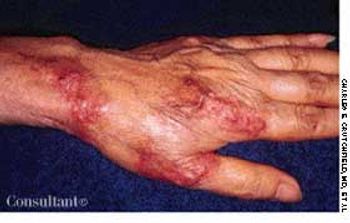
A 47-year-old woman from Southeast Asia presented with erythematous, asymmetric, anesthetic, sharply marginated plaques on her lower arms and hands. Because this patient had emigrated from a tropical climate, leprosy was suspected.

A 47-year-old woman from Southeast Asia presented with erythematous, asymmetric, anesthetic, sharply marginated plaques on her lower arms and hands. Because this patient had emigrated from a tropical climate, leprosy was suspected.
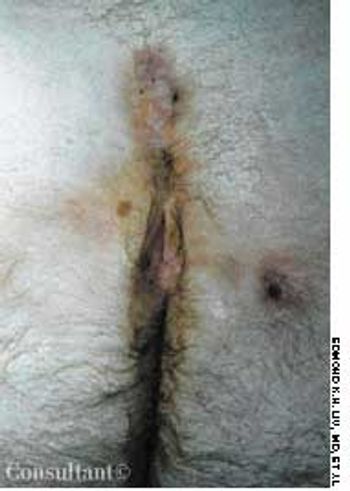
A 45-year-old man sought medical advice after suffering for 6 months with recurrent pain and a purulent discharge at the sacrococcygeal region. Two weeks before this consultation, an abscess on the patient's right buttock had been drained by another physician. The patient had insulin-dependent diabetes mellitus for 5 years; his medical history was otherwise unremarkable.
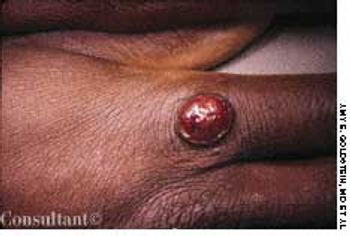
A 32-year-old man who had no significant medical history complained of “something growing on the knuckles of my right hand.” He reported that a “bump” was forming on the site of a cut he sustained while slaughtering sheep 3 weeks earlier. There was no blister, discharge, or pain. The patient denied any fever, cough, or malaise. He also did not recall seeing any lesions or “bumps” on the sheep.
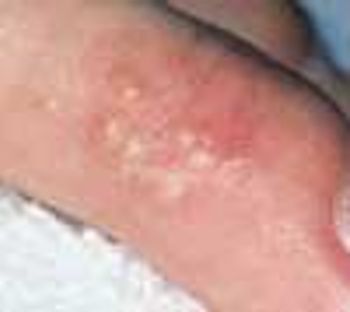
A 40-year-old dental assistant requested a prescription for antibiotics to treat the acute outbreak of painful, deep blisters that had recurred on her index finger. Prior eruptions of similar lesions had been diagnosed as staphylococcal infections and were treated with antibiotics.
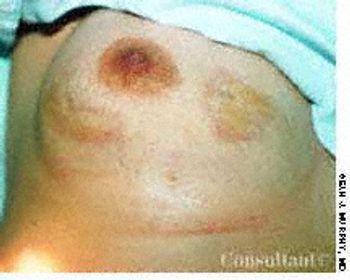
Two enlarging, dry, tender lesions had developed on the right breast of a 62-year-old woman 2 years before she sought medical consultation. The patient had no other symptoms; she was taking metoprolol succinate for cardiac arrhythmias.
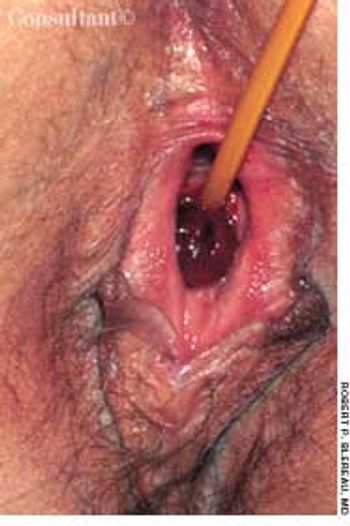
Following a cholecystectomy, an indwelling urethral catheter was placed in a 51-year-old woman with urinary retention. Five days later, the patient complained of a burning sensation at the site. A rounded, swollen, hemorrhagic area surrounding the catheter was noted, and a urinary tract infection was diagnosed.
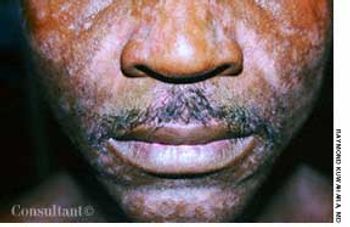
This 27-year-old man complained that a facial rash of several years' duration had worsened during the past few months. Hypopigmented macules with scale were especially prominent on the eyebrows and in the nasolabial folds; a moderate amount of scale was noted on the scalp. The patient was seropositive for HIV.
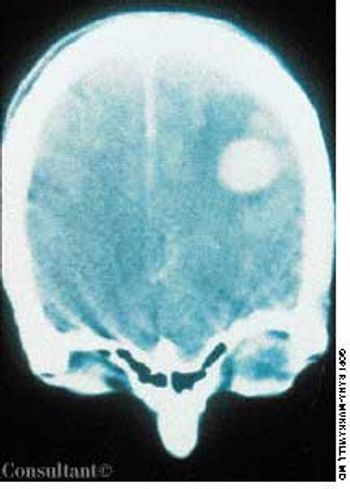
A 32-year-old man who had HIV disease complained of headache, fever, and weakness on his right side. His history included intravenous drug use, Pneumocystis carinii pneumonia, and mucocutaneous candidiasis.
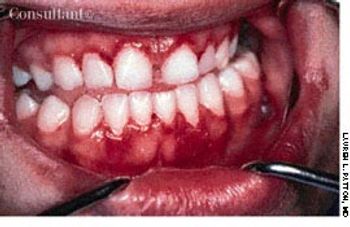
Bleeding gums for the past 2 days was the complaint of this 22-year-old woman. She is HIV-positive but has been clinically asymptomatic. Her CD4 lymphocyte count is 84/μL, and her viral load is 160,885 copies/mL. Despite maintaining good oral hygiene, she has a distinct fiery red band along the gingival margin.
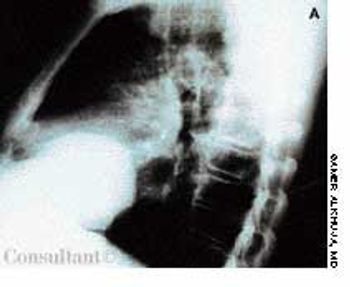
During the assessment of an 83-year-old man who had an infected arteriovenous graft, chest films showed a masslike density in the lower right hemithorax.
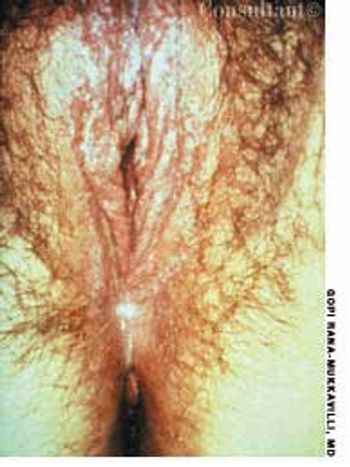
For 3 days, a 23-year-old woman had been bothered by pruritic vaginal and vulvar lesions. A cheesy white vaginal discharge was associated with the itching.
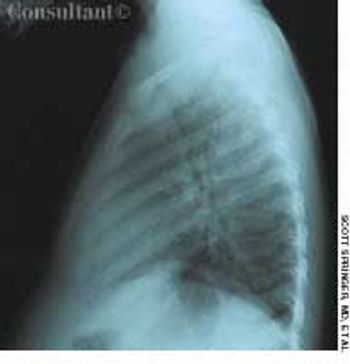
The parents of a 2-year-old boy with a 3-day history of fever took him to the emergency department. The child's temperature fluctuated between 38°C (100.4°F) and 39°C (102.2°F). As part of the workup, chest films were taken.
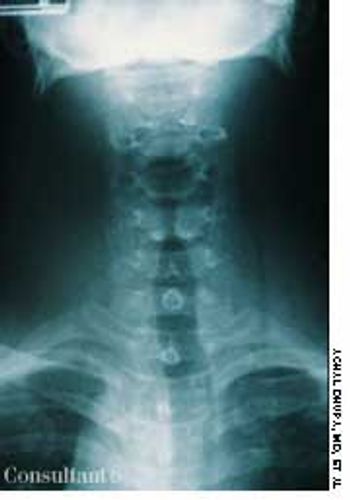
A 32-year-old man was brought to the emergency department after being stabbed in the right side of the neck with a broken piece of glass. The patient immediately underwent carotid angiography; the findings were normal.
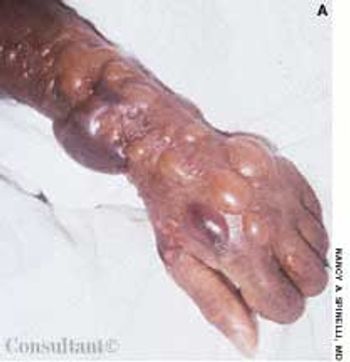
A 79-year-old nursing home resident was hospitalized for evaluation of hyperkalemia and leukocytosis. Her medical history included hypertension, respiratory failure with subsequent tracheostomy placement and ventilator dependency, and anemia. Both of her legs had been amputated above the knee secondary to complications of type 2 diabetes mellitus.

After 3 months of seeing this painless mass at the angle of the 3-year-old's left jaw, his parents sought medical advice for their son. The youngster had no constitutional symptoms. A Mantoux test was performed, and an erythematous, indurated area measuring 15 mm in diameter was found at the test site 48 hours later.
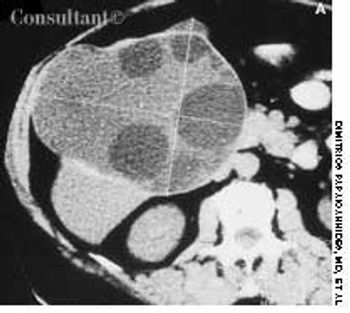
A 65-year-old woman was admitted to the hospital with abdominal discomfort and constipation. A nontender mass was palpated in the right hypochondrium.
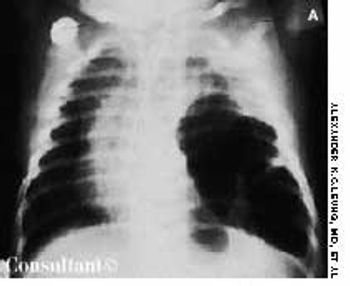
An irritable, lethargic, toxic-looking, and slightly cyanotic 2-month-old boy had a temperature of 40°C (104°F), malaise, and a cough for 2 days. The infant's heart rate was 98 beats per minute, and his respiratory rate was 55 breaths per minute. He had nasal flaring, sternal and subcostal retractions, diminished breath sounds, and scattered rales over the left lung, which was dull to percussion.
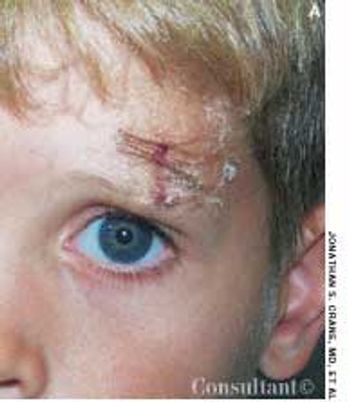
During a camping trip, a 7-year-old boy sustained a 1.5-cm laceration down to the bone above the left eyebrow. The laceration was clean and linear; it bled freely. The patient did not lose consciousness.
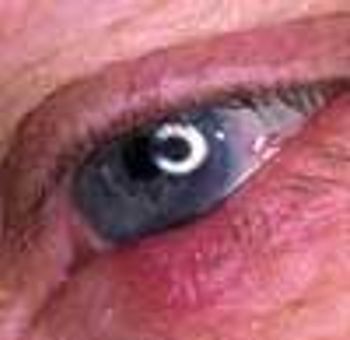
A mildly itchy, tender “red bump” on his eyelid concerned a 68-year-old man. Two years earlier, a basal cell carcinoma, which started as a “red bump,” had been removed from his cheek. This lesion had been present for 2 weeks; the patient noted a small amount of discharge at the site in the mornings.

A 76-year-old man reported a 3-month history of an asymptomatic, raised, reddened lesion on his penis. The patient had type 2 diabetes mellitus. In 1994, a basal cell carcinoma had been excised from his chest and, 3 years later, a squamous cell carcinoma was excised from his left temple.
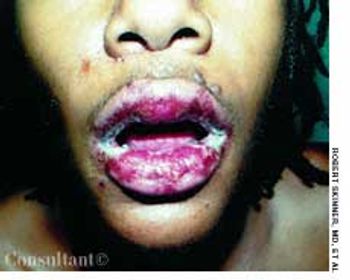
A 28-year-old man presented to the emergency department with a 1-week history of multiple, concentric, erythemic, targetlike plaques over the entire body. Severe necrosis and hemorrhagic crusting were evident on the oral mucosa and lesions were present on the upper lip. The remainder of the physical examination was unremarkable. The patient had no known medical problems, was seronegative for HIV, and denied a history of herpes simplex virus (HSV) infection. He used no medications.
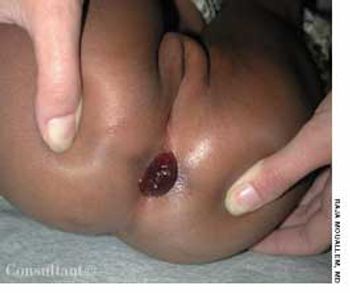
A 2-year-old girl presents to the pediatric emergency department (ED) for evaluation of a fleshy mass protruding from her rectum. The mass, which had been present for 1 day, protruded spontaneously and not during defecation. There is no history of cough, constipation, diarrhea, vomiting, weight loss, or parasitic or chronic disease. However, the child has been having episodic, painless bleeding during the past month. There is no family history of GI disease.
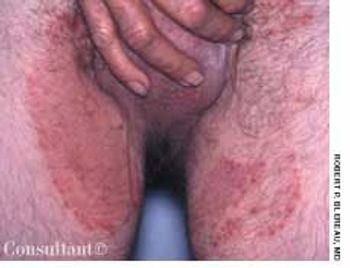
A 56-year-old man had an asymmetric, maculopapular, sharply demarcated, pruritic, excoriated dermatitis on his upper thighs. The eruption had been present for 2 to 3 weeks.
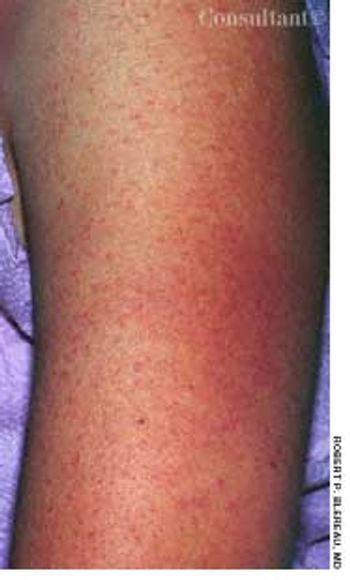
Tiny, asymptomatic "bumps" had been present for 4 years on the posterolateral surface of the upper arms of a 34-year-old woman. Similar but less severe eruptions also appeared on her forearms and anterior thighs.
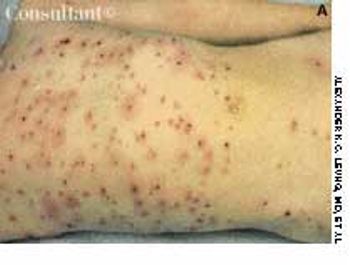
A pruritic, erythematous rash developed in a 6-year-old boy over the previous 5 days. The rash erupted in crops; the lesions appeared initially as rose-colored macules, progressed rapidly to papules and vesicles, and finally crusted. The distribution of the lesions-with the greatest concentration on the trunk-is typical of chickenpox.